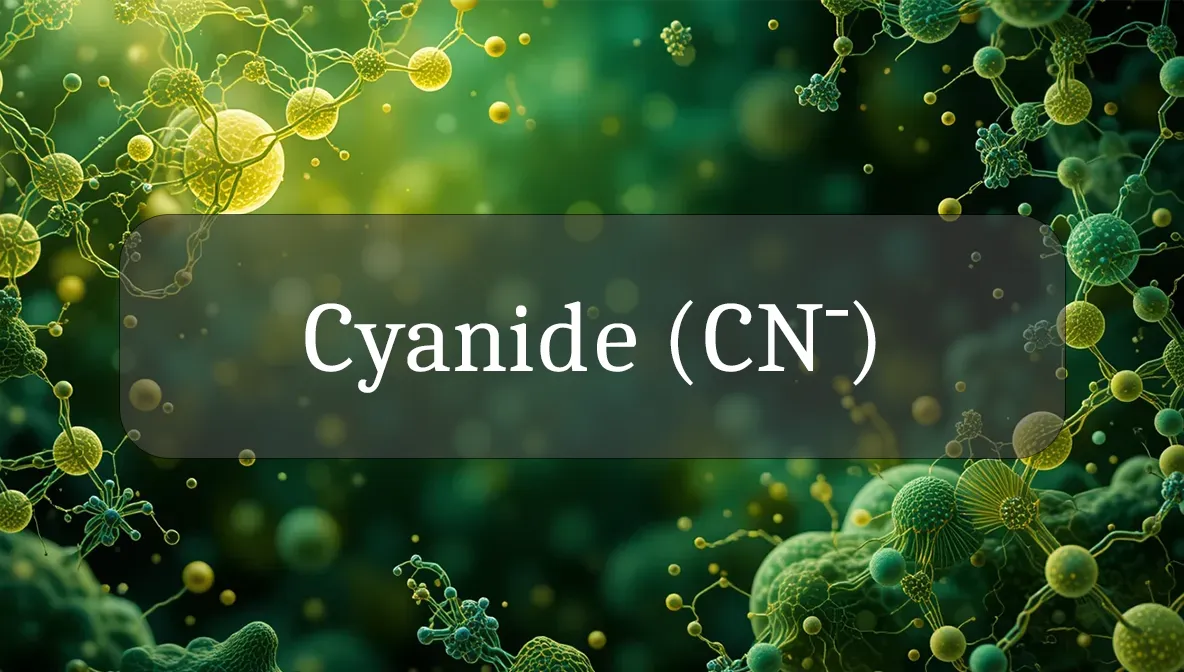Toxic Molecule and Its Health Implications
The cyanide ion (CN⁻) is a small but infamous molecule often associated with danger due to its toxic nature. Unlike nutrients like chloride, cyanide is not a beneficial part of your diet or wellness routine. Instead, it’s a chemical compound that can pose serious health risks. For health-conscious readers, understanding cyanide is important to stay safe and informed, especially since it can be found in certain foods and environments. Let’s break down what cyanide is, its effects on the body, and how to avoid its dangers in a clear, engaging way.
Chemical Identity and Type
The cyanide ion (CN⁻) is a negatively charged molecule made of one carbon (C) atom bonded to one nitrogen (N) atom. It’s a simple but highly reactive compound that can bind tightly to enzymes in your body, disrupting critical processes. Cyanide exists in various forms, such as hydrogen cyanide (HCN, a gas) or salts like sodium cyanide (NaCN), and is found naturally in some plants, seeds, and industrial settings. Its toxicity makes it a molecule to approach with caution rather than a nutrient to seek out.
Biological Role and Benefits
Unlike essential nutrients, cyanide has no beneficial biological role in the human body. Instead, it’s a potent toxin that interferes with your cells’ ability to use oxygen. Specifically, cyanide binds to an enzyme called cytochrome c oxidase in your mitochondria (the “powerhouses” of your cells), halting energy production. This can lead to severe health effects, even in small amounts. While cyanide has no health benefits, understanding its risks is key to avoiding accidental exposure and protecting your wellness.
Dietary or Natural Sources
Cyanide occurs naturally in small amounts in certain foods and plants, and it’s also present in some industrial or environmental contexts. Common sources include:
- Certain seeds and pits: Apple seeds, apricot pits, peach pits, and cherry pits contain amygdalin, a compound that can release cyanide when broken down in the body.
- Cassava (manioc): This root vegetable, common in tropical diets, contains cyanogenic glycosides that can produce cyanide if not properly processed (e.g., peeled, soaked, or cooked).
- Bamboo shoots and almonds: Some varieties, especially bitter almonds, contain cyanide-releasing compounds.
- Environmental exposure: Cyanide can be found in cigarette smoke, industrial chemicals (used in mining or plastics), or accidental exposure from fires releasing toxic fumes.
- Contaminated water or soil: Rarely, cyanide may contaminate water supplies near industrial sites.
Proper food preparation (like cooking or fermenting cassava) removes most cyanide, making these foods safe to eat.
Signs of Imbalance or Dysfunction
Since cyanide is a toxin, there’s no “deficiency” state, but exposure to even small amounts can cause serious symptoms. Signs of cyanide poisoning include:
- Mild exposure: Dizziness, headache, nausea, confusion, or rapid breathing.
- Moderate to severe exposure: Rapid heartbeat, weakness, seizures, loss of consciousness, or difficulty breathing.
- Critical exposure: Coma, heart failure, or respiratory failure, which can be fatal without immediate treatment.
Causes of exposure: Accidental ingestion of seeds/pits, improper preparation of foods like cassava, or inhalation of cyanide gas from industrial accidents or smoke.
If you suspect cyanide exposure, seek emergency medical help immediately, as it’s a life-threatening condition.
Supporting Optimal Levels or Function
Since cyanide is harmful, the goal is to avoid exposure rather than support its presence. Here are practical tips to stay safe:
- Prepare foods properly: Peel, soak, and cook cassava thoroughly. Avoid eating large amounts of fruit pits or seeds (e.g., apple or apricot seeds).
- Limit risky foods: Bitter almonds and certain wild plants should be consumed cautiously or avoided unless processed to remove cyanogenic compounds.
- Be mindful of environmental risks: Avoid areas with potential industrial cyanide contamination, and use proper ventilation if working in high-risk settings.
- Quit smoking: Cigarette smoke contains trace amounts of cyanide, so quitting reduces your exposure while improving overall health.
- Emergency preparedness: If you work in industries where cyanide is used (e.g., mining or chemical manufacturing), follow safety protocols and know the signs of poisoning.
For most people, cyanide exposure is rare and preventable with basic precautions.
Safety, Interactions, and Precautions
Cyanide is highly toxic, so safety is critical. Here are key precautions:
- Toxicity: Even small amounts of cyanide can be dangerous, with as little as 200 mg of ingested cyanide or 0.1 ppm of inhaled hydrogen cyanide potentially fatal.
- Interactions: Cyanide doesn’t interact with medications in the traditional sense, but it can worsen conditions like heart or lung disease by reducing oxygen use.
- High-risk groups: People with respiratory issues, heart conditions, or those exposed to industrial chemicals are more vulnerable to cyanide’s effects.
- First aid: If cyanide poisoning is suspected, immediate medical intervention (e.g., antidotes like hydroxocobalamin or sodium thiosulfate) is critical. Do not attempt home remedies.
Always handle cyanide-containing foods with care, and seek professional advice if you’re unsure about a food or environmental risk.
Fun Fact
Did you know cyanide played a role in the discovery of enzymes? Scientists studying how cyanide blocks oxygen use in cells helped uncover the role of mitochondria in energy production, advancing our understanding of cellular biology!
Citations
- National Institutes of Health (NIH), PubChem: Cyanide Ion.
- World Health Organization (WHO): Cyanide in Drinking-Water.
- Mayo Clinic: Cyanide Poisoning.
- Centers for Disease Control and Prevention (CDC): Facts About Cyanide.
- Food and Agriculture Organization (FAO): Cassava Processing and Safety.

